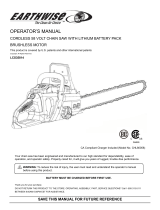
8
ENGLISH
(Original instructions)
9
ENGLISH
(Original instructions)
Check for misalignment or binding of moving parts,
breakage of parts and any other condition that may
affect the power tools operation. If damaged, have the
power tool repaired before use. Many accidents are
caused by poorly maintained power tools.
f. Keep cutting tools sharp and clean. Properly
maintained cutting tools with sharp cutting edges are less
likely to bind and are easier to control.
g. Use the power tool, accessories and tool bits etc. in
accordance with these instructions, taking into
account the working conditions and the work to be
performed. Use of the power tool for operations different
from those intended could result in a hazardous situation.
5. Battery tool use and care
a. Recharge only with the charger specied by the
manufacturer. A charger that is suitable for one type of
battery pack may create a risk of re when used with
another battery pack.
b. Use power tools only with specically designated
battery packs. Use of any other battery packs may create
a risk of injury and re.
c. When battery pack is not in use, keep it away from
other metal objects, like paper clips, coins, keys,
nails, screws, or other small metal objects, that can
make a connection from one terminal to another.
Shorting the battery terminals together may cause burns
or a re.
d. Under abusive conditions, liquid may be ejected from
the battery; avoid contact. If contact accidentally
occurs, ush with water. If liquid contacts eyes,
additionally seek medical help. Liquid ejected from the
battery may cause irritation or burns.
6. Service
a. Have your power tool serviced by a qualied repair
person using only identical replacement parts. This will
ensure that the safety of the power tool is maintained.
@
Warning! Additional safety warnings for
Chainsaws.
u Keep all parts of the body away from the saw chain
when the chainsaw is operating. Before you start the
chainsaw, make sure the saw chain is not contacting
anything. A moment of inattention while operating chain
saws may cause entanglement of your clothing or body
with the chain saw.
u Always hold the chainsaw with your right hand on the
rear handle and your left hand on the front handle.
Holding the chainsaw with a reversed hand conguration
increases the risk of personal injury and should never be
done.
u Hold the power tool by insulated gripping surfaces
only, because the saw chain may contact hidden
wiring. Saw chains contacting a "live" wire may make
exposed metal parts of the power tool "live" and could give
the operator an electric shock.
u Wear safety glasses and hearing protection. Further
protective equipment for head, hands, legs and feet is
recommended. Adequate protective clothing will reduce
personal injury by ying debris or accidental contact with
the saw chain.
u Do not operate a chainsaw in a tree. Operation of a
chainsaw while up in a tree may result in personal injury.
u Always keep proper footing and operate the chain saw
only when standing on xed, secure and level surface.
Slippery or unstable surfaces such as ladders may cause
a loss of balance or control of the chainsaw.
u When cutting a limb that is under tension be alert
for spring back. When the tension in the wood bres is
released the spring loaded limb may strike the operator
and/or throw the chain saw out of control.
u Use extreme caution when cutting brush and saplings.
The slender material may catch the saw chain and be
whipped toward you or pull you off balance.
u Carry the chain saw by the front handle with the chain
saw switched off and away from your body. When
transporting or storing the chainsaw always t the
guide bar cover. Proper handling of the chain saw will
reduce the likelihood of accidental contact with the moving
saw chain.
u Follow instructions for lubricating, chain tensioning
and changing accessories. Improperly tensioned or
lubricated chain may either break or increase the chance
for kickback
u Keep handles dry, clean, and free from oil and grease.
Greasy, oily handles are slippery causing loss of control.
u Cut wood only. Do not use chainsaw for purposes
not intended. For example: do not use the chainsaw for
cutting plastic, masonry or non-wood building materi-als.
Use of the chainsaw for operations different than intended
could result in a hazardous situation.
Causes and operator prevention of kickback
Kickback may occur when the nose or tip of the guide bar
touches an object, or when the wood closes in and pinches
the saw chain in the cut.
Tip contact in some cases may cause a sudden reverse reac-
tion, kicking the guide bar up and back towards the operator.
Pinching the saw chain along the top of the guide bar may
push the guide bar rapidly back towards the operator. Either of
these reactions may cause you to lose control of the chainsaw
which could result in serious personal injury. Do not rely
exclusively upon the safety devices built into your chainsaw.





















